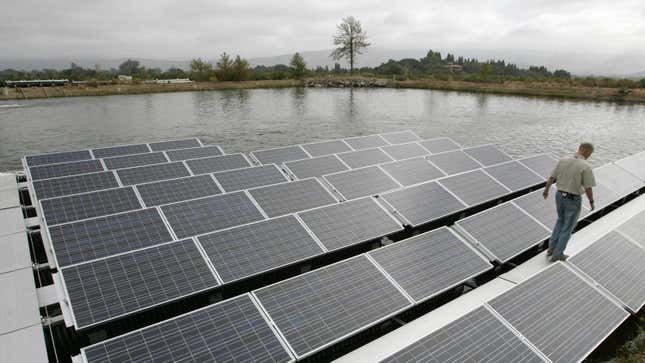
A new analysis finds that covering water canals in California with solar panels could save a lot of water and money while generating renewable energy. Doing so would generate between 20% and 50% higher return on investment than would be achieved by building those panels on the ground.
The paper, published Thursday in Nature Sustainability, performs what its authors call a techno-economic analysis, calculating the impacts and weighing the costs and benefits of potentially covering the thousands of miles of California’s open irrigation system.
“We have a water shortage in the West,” said Brandi McKuin, the paper’s lead author and a postdoctoral researcher at University of California, Santa Cruz, who collaborated with researchers at University of California, Merced for this paper. “We also have a mandate from the state to produce renewable energy at scale. If we’re going to meet net zero emissions by 2050, we need to stop relying on fossil fuels. This is an alternative solution that happens to have compounding benefits.”
California’s aqueduct system, which spans nearly 4,000 miles (6,437 kilometers), is a crucial part of delivering water throughout the state. The canals snake in and out from California’s Central Valley, the agricultural powerhouse of the state, moving water around to irrigate crops. There’s already intense pressure on this water system: While the California has technically recovered from its intense seven-year drought in the 2010s, it’s still teetering on the precipice as climate change and overuse wreak havoc the region’s water supply. Open irrigation canals aren’t helping either, as they allow precious water to evaporate.
But something as simple as covering those canals up could go a long way to helping deal with drought. Researchers performed a theoretical evaporation analysis based on hydrological modeling to estimate how much water the state could save per year with a cover, like solar panels.
“A lot of water gets evaporated just because we don’t put a lid on it,” McKuin said. “By covering canals with solar panels, we could save up to 63 billion gallons of water annually. It’s a lot of water. That’s roughly the amount of water needed to irrigate 50,000 acres of farmland, or to meet the residential needs of 2 million people.”
A growing number of cities across the globe are looking at ways to cover bodies of water with solar panels–namely, using floating panels. (The UC study looks at covering the canals with a system of cables, rather than floating systems.) Floating solar panels are growing in popularity around the world. Japan has made particular progress in installing floating arrays, and the technology is slowly catching on in the U.S. The largest array in the U.S is already in California: The city of Healdsburg said last month it had finished installing 11,600 panels on a wastewater treatment pond. In 2018, researchers at the National Renewable Energy Laboratory called for more widespread use of the technology in the U.S., estimating that covering the thousands of man-made reservoirs around the country could provide up to 10% of the country’s electricity.
Yet one of the big drawbacks of floating solar panels is the cost; they’re around 10% to 15% more expensive to install compared to land arrays. But industry experts say the gap in cost is narrowing as technology improves and utilities and installers realize the benefits of floating panels that don’t come with installing panels on land, like the cooling impacts of water on panels that are prone to overheating.
The paper didn’t calculate the amount of energy that all these panels would provide, but McKuin has done some back-of-the-envelope math of her own. “This isn’t information that’s in the paper, but I estimate that it would provide 13 gigawatts of power,” she said. For context, California regulators are pushing to install 20 gigawatts of additional renewable capacity across the state by 2030.
And while the study didn’t specifically look at the impacts of the panels on ecosystems, the authors found there could be tangible benefits there, too.
“Aquatic weeds are a problem [in canals]. Water is scarce, and they take up water,” McKuin said. “There’s also problems that can happen. Roots can blow out drains and pipes and restrict flow, vegetation can blow into the canal, weeds get a foothold in the channel and can accumulate sediment and disrupt the flow [of water].”
Stopping sunlight from reaching aquatic weeds with solar panels, by contrast, could help reduce their growth and make it easier for water to flow. But, McKuin said, further research is definitely needed into how a project as big as covering thousands of miles of canals with solar panels could impact the environment.
“There’s always going to be a tradeoff,’ she said. “Maybe some ecosystems that really like canals could be affected. That’s something we’d have to study.”
Correction 3/18/21 3:18 PM: This piece has been updated to reflect the fact that the study did not specifically examine floating panels.